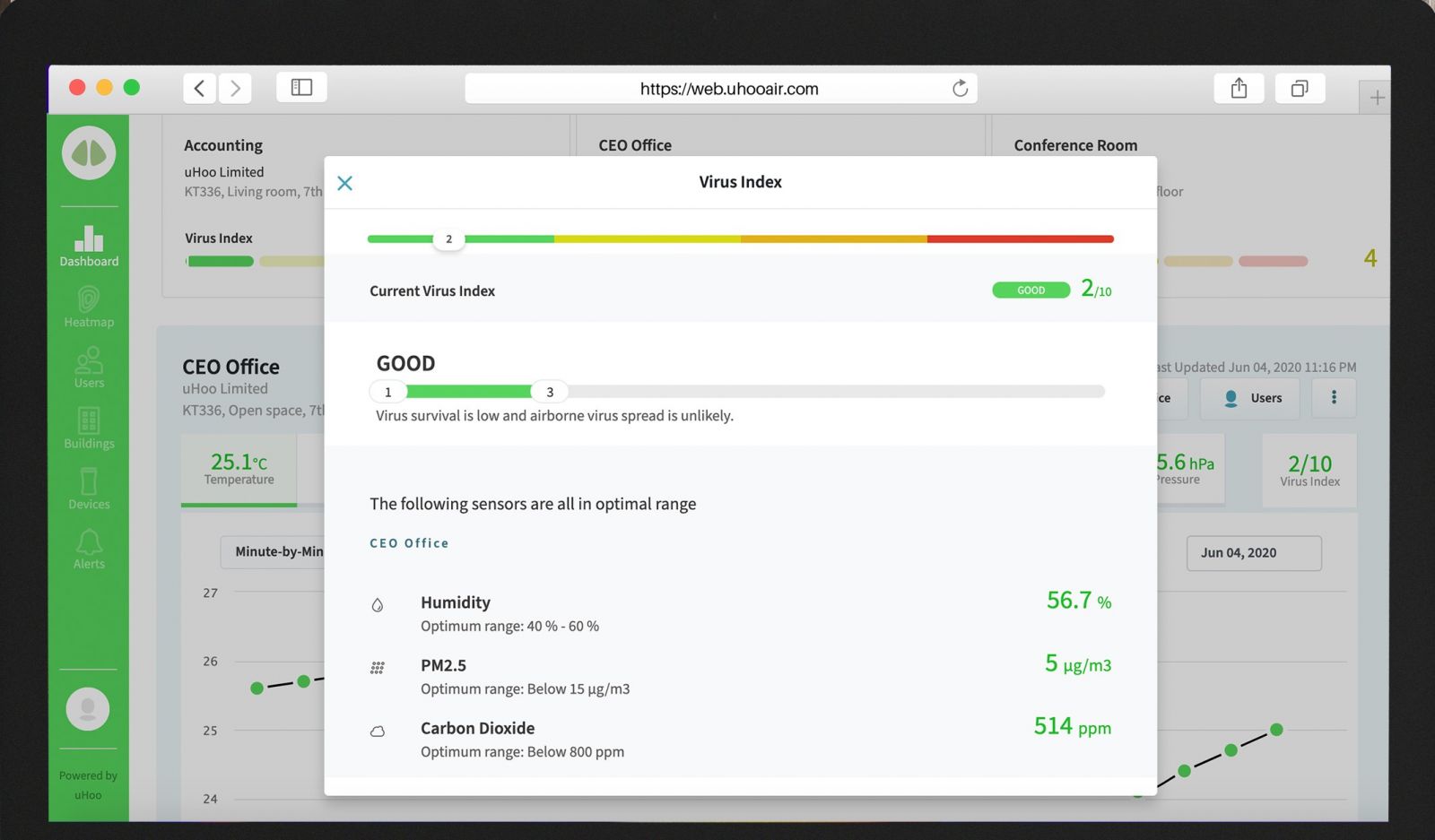Is There A 'Safer' Day Of The Week to Attend The Office?
In terms of virus transmission risk, are there days that are “safer” to attend the workplace than others? According to the Infogrid Air Quality Index, only...
Read Full ArticleAir quality management company uHoo has suggested that 88 per cent of people want air quality data to be publicly displayed.
This would be as a means to assure people that the environment is being managed properly and is safe for them to enter.
uHoo has also discovered that COVID-19 has accelerated the movement from energy-efficient buildings to healthy buildings. Could better air quality reduce deaths and improve lives and wellbeing globally?
A healthy building is now the new minimum, and they have produced a uHoo Virus Index to help determine this. The index is the world's first real-time assessment of virus survival based on air quality.
The index works on a 10-point scoring system categorised into four levels: good, mild/moderate, bad and severe. Each level provides insights about air quality, the risk of sustaining viruses and how to improve the environment to reduce that risk.
“Research has already shown that there is a strong correlation between air quality and the survival of COVID-19 and other viruses."
–Graham Mills
Managing Director, AirProfiling Ltd
When it comes to buildings, the focus has always been on energy efficiency, sometimes at the expense of people’s health, argues uHoo. However, COVID-19 has meant that the issue of indoor air quality in our buildings has risen higher on the agenda.
Sick building syndrome, people falling ill in offices, temperature discomfort, and odours in buildings all stem from air quality, and affect our general health and wellbeing.
According to uHoo, A recent survey showed that 88% want air quality data to be publicly displayed on a large screen inside offices, building lobbies, restaurants, hotels, and any public establishment as a means to assure guests that the environment is being managed properly and is safe for them to enter.
Research published in the American Society of Microbiology showed that SARS-COV surrogate viruses (a coronavirus genetically very close to COVID-19), survive longer and can become airborne in specific combinations of temperature and humidity.
Particulate matter (mix of small particles and liquid droplets) can stay suspended in the air and become vectors of viruses, and may have potential health consequences.
Scientists from Harvard University also reported that long-term exposure to particulate matter increased the death rate of COVID-19 cases.

Picture: A screenshot of the business dashboard from uHoo's Indoor Air Quality Monitoring system
uHoo have launched an index to measures particulate in real-time and send alerts when it reaches unhealthy thresholds so action can be immediately taken.
The uHoo Indoor Air Quality Monitoring system is marketed in the UK by AirProfiling Ltd based in Newark, Nottinghamshire, on behalf of uHoo Limited, Hong Kong.
AirProfiling’s Managing Director, Graham Mills said “Research has already shown that there is a strong correlation between air quality and the survival of COVID-19 and other viruses. We can utilise uHoo’s air quality data within our homes and workplaces to create an environment that helps to deactivate viruses and, at the same time, enhance our immune system.”
Picture: A photograph of a person wearing a facial covering
Article written by Ella Tansley | Published 11 June 2020
In terms of virus transmission risk, are there days that are “safer” to attend the workplace than others? According to the Infogrid Air Quality Index, only...
Read Full ArticlePressure is mounting for FMs and building owners to deliver solutions capable of reducing the threat of airborne disease transmission in buildings, so is UV-C a viable...
Read Full ArticleA solution to remove COVID-19 from the air using UV sanitisers will soon be used in hospitals, after a team led by engineers from the Institution of Mechanical Engineers...
Read Full ArticleDuring the pandemic, COVID has raised the profile of the quality of the air we breathe in our buildings – how do we maintain this priority throughout the winter...
Read Full ArticleThe EnviroKlenz Air System is used to ensure clean air in a variety of high traffic environments, such as dentistry studios and school classrooms. According to...
Read Full ArticleImagine an office where, in the event of a pandemic, an app will inform tenants that the air conditioning is running on fresh air only and disinfecting UV lamps have been...
Read Full ArticleA report commissioned by the government’s chief scientific adviser Sir Patrick Vallance has highlighted the crucial role played by building ventilation in...
Read Full ArticleIndoor Air Quality has been at the front of our minds as we navigate through a global pandemic, and we have learned that effective air distribution can minimise the risk...
Read Full ArticleBureau Veritas is stressing the need to carry out indoor air quality surveys, swab-sampling programs and quantification of fresh air assessments, to ensure premises...
Read Full ArticleWith schools now closed until at least 8 March, what safety measures must schools take to support their reopening? Schools in England will now be closed to all but...
Read Full Article